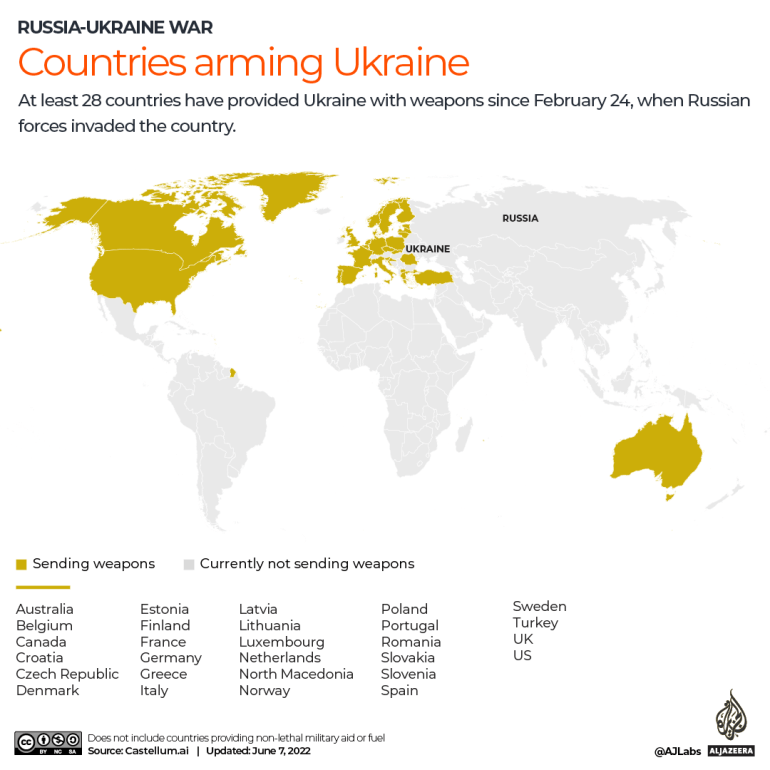The United Kingdom has pledged to deliver more than a dozen battle tanks to Ukraine as it continues to fight Russia’s invading forces.
Moscow has reacted with fury, saying that all of the units that the UK plans to send “will burn” and do nothing to alter the outcome of its nearly yearlong war.
The UK announcement is likely to increase pressure on Germany to allow the export of German-made tanks to Ukraine, as several European countries await Berlin’s approval.
Here’s what you need to know:
Why is Ukraine calling for tanks?
The Ukrainian government has repeatedly pleaded for additional weapons – including battle tanks – from its Western allies to bolster its effort to push Russian forces out of the country.
Until now, Ukraine has relied primarily on Soviet-era T-72 tank variants.
Battle tanks designed by NATO countries – such as those produced by the UK and Germany – would provide Kyiv’s forces with better protection, and more accurate firepower.
However, they would not provide an instantaneous boost in terms of combat capability because Ukrainian forces would need to be trained to use any tanks supplied by Western allies – a process that is likely to take several weeks at least, if not longer.
Which countries have promised tanks?
The UK confirmed on Monday that it would send 14 of its Challenger 2 main battle tanks to Ukraine as well as other advanced artillery support in the coming weeks.
Among Kyiv’s other allies, Poland has said it is keen to send German-made Leopard 2 battle tanks to Ukraine as part of an international coalition, but requires Berlin’s approval to do so under rules governing the re-export of German military equipment.
Finland has also floated the possibility of supplying Ukraine with Leopard tanks, but said doing so depends on Germany’s lead.
Latvia, meanwhile, urged Kyiv’s allies to provide it with “all necessary support”.
“Ukraine should have all [the] necessary weapons … to resist this offensive. Therefore, all tanks should be given to Ukraine when possible,” Latvia’s President Egils Levits told Al Jazeera on Monday.

Are there divisions in the West’s response?
Germany has resisted supplying Ukraine with battle tanks so far, saying such units should only be provided to Kyiv if there is agreement among its main allies, particularly the United States.
The re-export of Leopards requires German government approval, so other countries with such tanks could not send them to Ukraine without it.
The US operates thousands of M1 Abrams tanks built by General Dynamics, but they are seen as unsuitable for Ukraine as they are driven by gas turbine engines.
Another key Ukrainian ally, France, has not said whether it would be willing to provide any of its own Leclerc tanks to Ukraine.
Earlier this month, the US said it would send dozens of Bradley armoured fighting vehicles to Ukraine, as Germany and France also committed to sending armoured vehicles.
A resolution concerning the Leopard 2 tanks could be reached on Friday, when Ukraine’s allies are due to hold talks in Germany over boosting military support for Ukraine.
The meeting in Ramstein comes as Chancellor Olaf Scholz faces mounting pressure to allow the export of Leopard 2 tanks.
Vice Chancellor Robert Habeck, whose economy ministry is responsible for approving defence exports, said on Thursday that Berlin should not stand in the way of countries that possess such units and want to supply them to Kyiv.

How has Russia reacted?
The Kremlin has said the tanks that the UK plans to send to Ukraine “will burn”.
“They [the UK] are using this country as a tool to achieve their anti-Russian goals,” Kremlin spokesman Dmitry Peskov told reporters on Monday when asked about the move.
“These tanks … will burn just like the rest,” he said, adding the new supplies would not change the situation on the ground in Ukraine.
Meanwhile, a pro-Kremlin presenter on the Rossiya 1 state television channel said the UK had “de facto entered the war” with its move to supply the units.
“I consider Britain is now a legitimate target for us,” Vladimir Solovyev said.
Will tanks make a difference in the war?
With Russian troops fortifying their positions in occupied parts of Ukraine’s east and south, and perhaps preparing for a new offensive in the months to come, battle tanks would provide Ukraine with a means to better defend itself and potentially make breakthroughs on the battlefield.
Experts at the International Institute for Strategic Studies (IISS), a British think-tank, said last week that about 100 tanks would be required for there to be “any significant effect on the fighting”.
“This would replenish Kyiv’s tank fleet, which has suffered attrition, and add to its capabilities,” the IISS said.
“While politically notable, the provision of a small number would in effect only be a token gesture,” it added.
Stay connected with us on social media platform for instant update click here to join our Twitter, & Facebook
We are now on Telegram. Click here to join our channel (@TechiUpdate) and stay updated with the latest Technology headlines.
For all the latest World News Click Here
